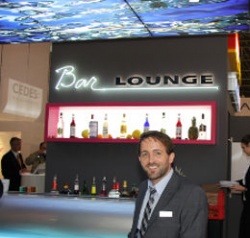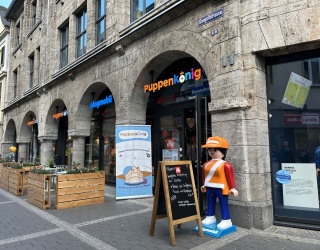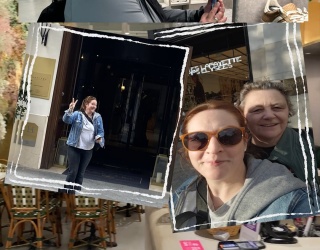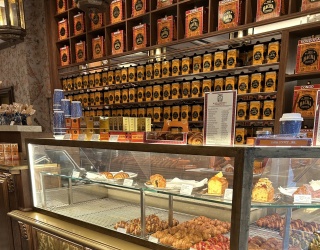Lighting Design has many different facets; one of them is illuminated signage. It is meant to create emphasis and stand out. It is especially important not to cross the line between tastefully striking and tacky and gaudy. Right before this year’s EuroShop, Hendrik Lenfers from guttenberger + partner spoke with us about light boxes, extremely thin StyLED characters and the elegant use of app-controlled RGB-LED.
Mr. Lenfers, the guttenberger + partner Company joined the EuroShop for the sixth time this year. How did the trade fair go for you?
It went very well. And it was really interesting, because we made many new contacts and had the chance to meet our regular customers personally. Of course, we still need to wait and see what will ultimately bear fruit.
Your booth had a very striking ceiling light.
Yes, we had a textile print design on an aluminum profile, which was attached to the ceiling and illuminated by LEDs behind it. Under this ceiling, you simply feel more comfortable than under a regular white ceiling. Many people especially liked this at the booth, because the ceilings in the hall are extremely high.
What types of light advertising are currently particularly in demand?
There are the light boxes for one, which we just talked about. They are used in shopfitting a lot. The advantage is that the customer can exchange the cover as often as he/she likes on their own and thus remain flexible with motifs. Oftentimes Stylet letters are being used here; those are full acrylic letters LEDs are poured into so that I get a slim, filigree letter.
How important is the use of energy-efficient lights for you?
We are essentially always offering LEDs. They save energy and are lower maintenance. We are also currently in the process of developing our own LEDs, so that we are truly able to offer one-stop shopping.
One-stop shopping is your comprehensive concept.
That’s right, because many companies use illuminated signage at this point. With us, full service also takes center stage. Our service also combines the architect, shopfitter etc. When the plan is illuminated signage, we clarify those items that need to be considered beforehand with our customer, for example if advertising is meant to be placed on facades. We also take care of administrative aspects for approval et cetera.
What projects do you like to look back on?
My most beautiful project for instance was an illuminated ceiling in Vienna. We also implemented a project with a RGB LED single letter sign at the University of Applied Sciences in Hamm, Germany, which is also able to render different colors. The customer can program the color gradient and reflect it on the face of the building.
To what extent are controls a subject in light advertising?
Daylight detection controls make sure that the advertising structures adjust to the light intensity of the environment. This way you can also save energy as a side benefit. Interval timers are also being used of course. At the University of Applied Sciences for instance, the gradient can be controlled by an app on your cell phone.
What is important when you design illuminated signage?
I personally respond better to a store at night where the light is harmonized versus a store where the light is mashed and wildly mixed. The overall concept needs to be right and attract me.
How do you implement this with RGB lighting?
So far, RGB lighting is not as popular yet. You often associate it with junk stores with neon signs and flashing lights. However, if it is used skillfully, it fits into a building’s architecture. For Motel One for instance, we retrofitted one object with RGB panels; in this case, the lighting forms a relationship with the architecture.
Natascha Mörs, initial publication EuroShop.de









